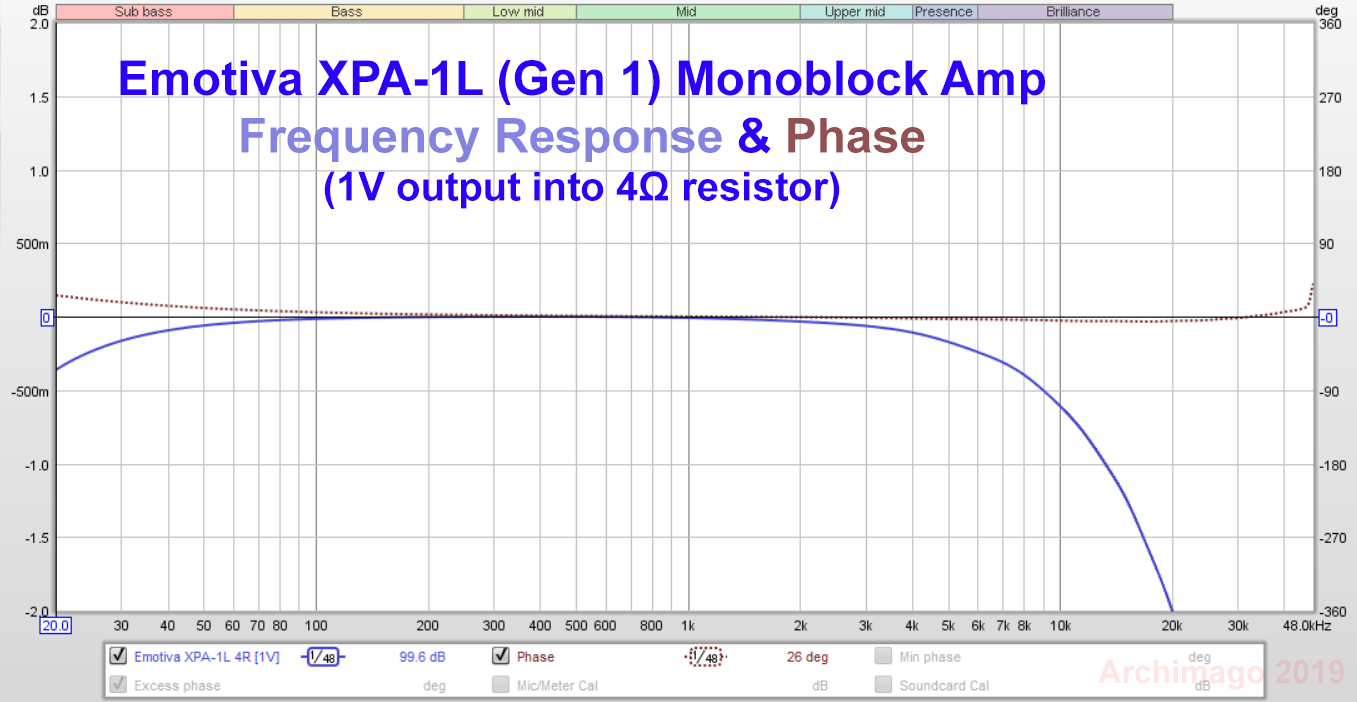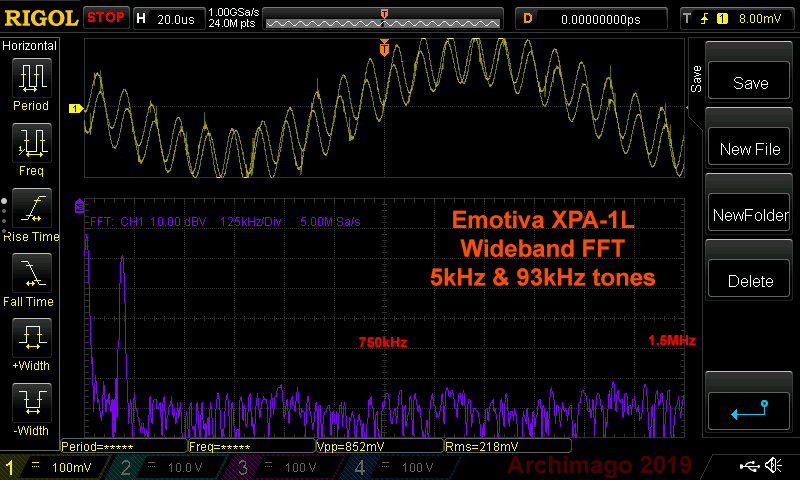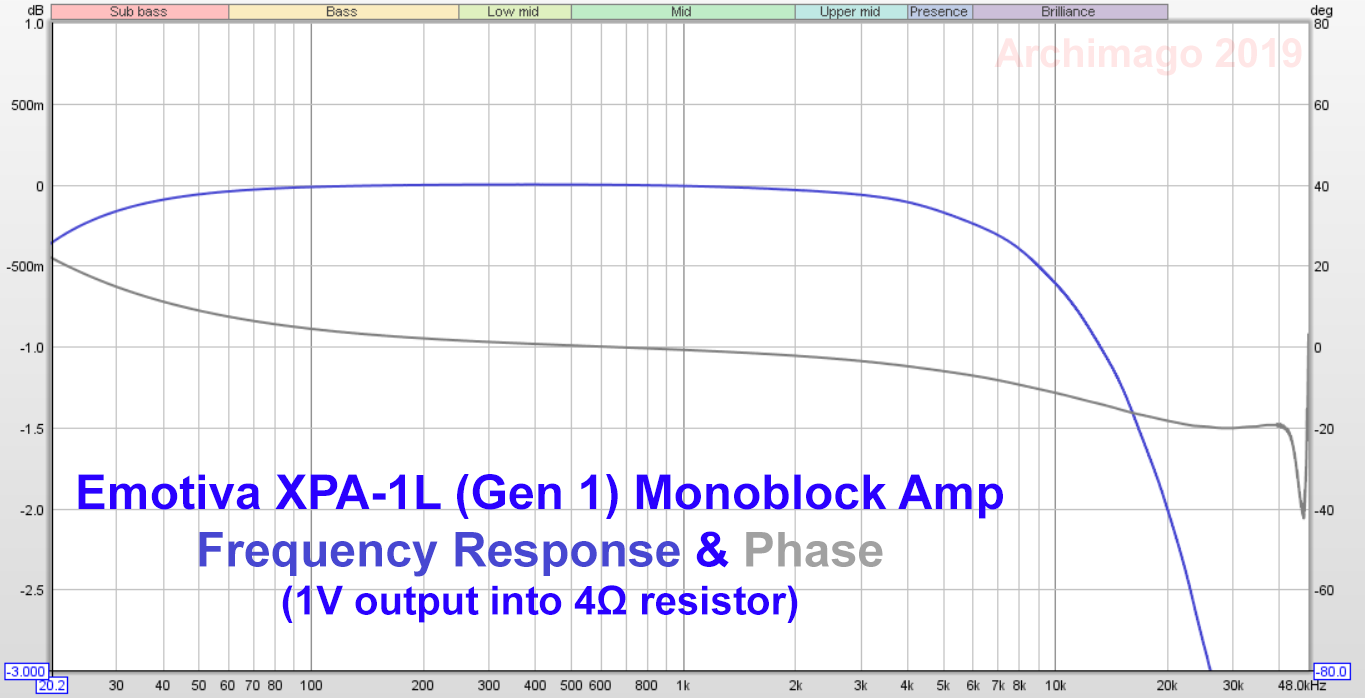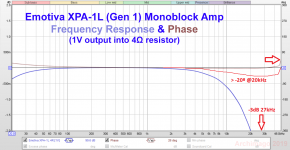The resistor change is postponed, so I can do the test.
AV Marantz SR4500 (modded) with almost 6º more at 20 kHz
Marantz SR4500 A/V Receiver HT Labs Measures | Sound & Vision

[Big IMG, link] http://maty.galeon.com/WP-imagenes/kef-q100/Rephase-PPEQ-KEF-q100-more-6-degree-phase-response.png
I am sorry to announce that the sound is worse, with less body, less magic, less...
AV Marantz SR4500 (modded) with almost 6º more at 20 kHz
Marantz SR4500 A/V Receiver HT Labs Measures | Sound & Vision

[Big IMG, link] http://maty.galeon.com/WP-imagenes/kef-q100/Rephase-PPEQ-KEF-q100-more-6-degree-phase-response.png
I am sorry to announce that the sound is worse, with less body, less magic, less...
AV Marantz SR4500 (modded) with something 2º more at 20 kHz
I have changed the phase scale to -10º.
[Big IMG, link] http://maty.galeon.com/WP-imagenes/kef-q100/Rephase-PPEQ-KEF-q100-more-2-degree-phase-response.png
Hummm. Sound more clear, a little less soundstage. Lesss magic too.... versus without. Better than with 6º without any doubt.
Maybe with 1º at 20 kHz....
Again without. Sound with body, more soundstage, depth. Therefore better not to touch anything, at least in this system. And without 0.6 dB at 40 Hz, for now.
I have changed the phase scale to -10º.
An externally hosted image should be here but it was not working when we last tested it.
[Big IMG, link] http://maty.galeon.com/WP-imagenes/kef-q100/Rephase-PPEQ-KEF-q100-more-2-degree-phase-response.png
Hummm. Sound more clear, a little less soundstage. Lesss magic too.... versus without. Better than with 6º without any doubt.
Maybe with 1º at 20 kHz....
Again without. Sound with body, more soundstage, depth. Therefore better not to touch anything, at least in this system. And without 0.6 dB at 40 Hz, for now.
Last edited:
To finish, it is well known or it should be known that the output phase in an amplifier should be as flat as possible, and not only in the audible band, but at least it should not exceed 6 degrees at 20 kHz.
Maty, Maty, Maty. All your arguments are simply “proof by vigorous assertion”. PLEASE perform some properly executed Double Blind Tests (DBT) to give some creditability to your assertions. Until then I can only give your arguments the same credence as those who claim putting wooden supports under speaker cables makes a “huge” difference in sound quality. Your lack of any credible evidence (i.e. DBT) might also explain why you were temporarily banned from audiosciencereview.com.
Before I have listen to a modern "jazz" digital recording: Anouar Brahem - Blue Maqams (2017), Digital Download, ECM, {24-96} [FLAC]
It lacks life, magic .. The first thing I have thought is that they have had to use digital filters with linear phase instead of minimal phase during production. The same sensation when I made the test weeks ago with a VSTplugin linear phase PEQ in JRiver MC.
It lacks life, magic .. The first thing I have thought is that they have had to use digital filters with linear phase instead of minimal phase during production. The same sensation when I made the test weeks ago with a VSTplugin linear phase PEQ in JRiver MC.
Today, Archimago's Musings: MEASUREMENTS: Emotiva XPA-1L (Gen 1) Class AB Balanced Monoblock


Flat phase response as one expects with Class AB devices from 20Hz to 48kHz.
Something else also known:
With a Class AB amplifier like this, one does not expect to see much ultrasonic noise unlike "switching" Class D amps where we often can find 400-500kHz content:

Yup, we can easily see the double peaks at 5kHz and 93kHz (notice the roll-off of the 93kHz vs. 5kHz). Otherwise, nice and clean all the way up to 1.5MHz. Nothing to see here folks...
You claimed understand how minimum phase works, then holy cow how can a response that looks be fallen to a -3dB point about 27kHz area have flat as a pancake phase out to 48kHz
Below is probably how that Archimago graph should have looked as i also told back in post 102 for the Onkyo graph, my guess is he miss some calibration setting stuff somewhere in REW to allign time 100% for measurement chain.
Attachments
Neither the amplifier nor the measurements are mine, nor are those of the other amplifiers, including the Hypex NC400.
I can only write about my listening experience with the manipulation of the phase with rePhase. If the program emulates Hypex NC400 correctly or not, I cannot verify that.
The desirable thing is that some Hypex NC user made a simulation with rePhase and told us if the sound improved or worsened. In my second system the differences are very noticeable, much more than I thought!
The graphic has also missed me for being very flat. Typically, there are very few degrees of deviation at 20 kHz and not any. Or Emotiva did very well or there is some error in the measurement.
It would be best to ask the author, Archimago.
I can only write about my listening experience with the manipulation of the phase with rePhase. If the program emulates Hypex NC400 correctly or not, I cannot verify that.
The desirable thing is that some Hypex NC user made a simulation with rePhase and told us if the sound improved or worsened. In my second system the differences are very noticeable, much more than I thought!
The graphic has also missed me for being very flat. Typically, there are very few degrees of deviation at 20 kHz and not any. Or Emotiva did very well or there is some error in the measurement.
It would be best to ask the author, Archimago.
Last edited:
My advice in the post:
Archimago's Musings: MEASUREMENTS: Emotiva XPA-1L (Gen 1) Class AB Balanced Monoblock
Archimago's Musings: MEASUREMENTS: Emotiva XPA-1L (Gen 1) Class AB Balanced Monoblock
Neither the amplifier nor the measurements are mine, nor are those of the other amplifiers, including the Hypex NC400.
I can only write about my listening experience with the manipulation of the phase with rePhase. If the program emulates Hypex NC400 correctly or not, I cannot verify that.
The desirable thing is that some Hypex NC user made a simulation with rePhase and told us if the sound improved or worsened. In my second system the differences are very noticeable, much more than I thought!
The graphic has also missed me for being very flat. Typically, there are very few degrees of deviation at 20 kHz and not any.
It would be best to ask the author, Archimago.
Right they are not yours but you distribute them without quality controll together a homebrew message of yours than phase should be zero degree @20kHz for any power amp to sound good.
About that NC400 emulation you also continue do it wrong in only dial on phase domain but that NC400 have also a amplitude rolloff so a better method had been "Minimum-Phase Filters" tab as told pages back and set a 1st or 2nd order LP rolloff and adjust/dial on frq number until phase trace hit the magical offset target number.
I will do the test you say although I would be surprised if the sound did not worsen so much, which is a lot. What interests me is to get excited with the type of recordings I listen to. I am indifferent to the type of amplifier and its price, I judge by the sound.
Of course, I will do it after some NC user does and comments here.
Of course, I will do it after some NC user does and comments here.
Oh no please not again we have been through it one time pages back...look at amplitude response trace its really not smooth in it starts a rise and probably explode in a ugly huge overshoot and its that enourmous minimum phase distortion (PEQ like HF boost) that help phase trace stay at zero degree.
Oh no please not again we have been through it one time pages back...look at amplitude response trace its really not smooth in it starts a rise and probably explode in a ugly huge overshoot and its that enourmous minimum phase distortion (PEQ like HF boost) that help phase trace stay at zero degree.
You are assuming instead... I just sent an email to Bosc designer with the link.
Thank you!


To me it is bad because > 6º at 20 kHz.Reasonable looking phase response I think from 20Hz to 48kHz. We're seeing about -20° at 20kHz corresponding with the frequency roll-off.
Last edited:
Thanks guys. Updated the phase FR graph.
...

...To me it is bad because > 6º at 20 kHz.
..
One of the advantages of amplifiers with high bandwidth, usually up to 350 kHz to avoid RF problems, is that in addition to flattening the frequency response < 20 kHz they also do the same with the phase -> better sound.
Of course, very good recordings and with great dynamic range are assume.
****** *******
The improvement in sound is incredible compared to a few months ago.
Art Farmer Benny Golson Jazztet - Here And Now / Another Git Together (1962), CD, Universal 2012, US
Of course, very good recordings and with great dynamic range are assume.
****** *******
The improvement in sound is incredible compared to a few months ago.
Art Farmer Benny Golson Jazztet - Here And Now / Another Git Together (1962), CD, Universal 2012, US
Last edited:
Phase Shift (measurement)
Relevance of the Phase Shift to an audio amplifier
Already a simple phase shift causes a changed signal. Phase shifts cause linear distortions, it add for the signal however no new frequencies. While nonlinear distortions the signal add new frequencies and are acoustically more clearly audible. Ideal way should exhibit a Hifi amplifier only little phase shift within the audio range. In order to ensure however a small phase shift of e.g. only one degree with 20 kHz, the range of the Hifi amplifier must be nevertheless already properly high, a range of 50 kHz is not sufficient by far not. A high bandwidth of a Hifi amplifier is favourable and necessary, in order to achieve a very small phase shift within the audio range. Thus linear distortions can be reduced very much. Surely, linear distortions do not have the same important acoustic effects as nonlinear distortions. In addition, linear distortions do not correspond in the slightest to the ideal picture of a amplifier...
- Home
- Amplifiers
- Class D
- Phase shift in class D amplifiers. How it affects the sound?

.jpg/:/cr=t:0%25,l:0%25,w:100%25,h:100%25)